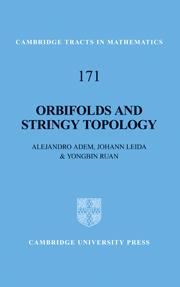1 - Foundations
Published online by Cambridge University Press: 05 October 2009
Summary
Classical effective orbifolds
Orbifolds are traditionally viewed as singular spaces that are locally modeled on a quotient of a smooth manifold by the action of a finite group. In algebraic geometry, they are often referred to as varieties with quotient singularities. This second point of view treats an orbifold singularity as an intrinsic structure of the space. For example, a codimension one orbifold singularity can be treated as smooth, since we can remove it by an analytic change of coordinates. This point of view is still important when we consider resolutions or deformations of orbifolds. However, when working in the topological realm, it is often more useful to treat the singularities as an additional structure — an orbifold structure — on an underlying space in the same way that we think of a smooth structure as an additional structure on a topological manifold. In particular, a topological space is allowed to have several different orbifold structures. Our introduction to orbifolds will reflect this latter viewpoint; the reader may also wish to consult the excellent introductions given by Moerdijk [112, 113].
The original definition of an orbifold was due to Satake [139], who called them V -manifolds. To start with, we will provide a definition of effective orbifolds equivalent to Satake's original one.
- Type
- Chapter
- Information
- Orbifolds and Stringy Topology , pp. 1 - 31Publisher: Cambridge University PressPrint publication year: 2007

